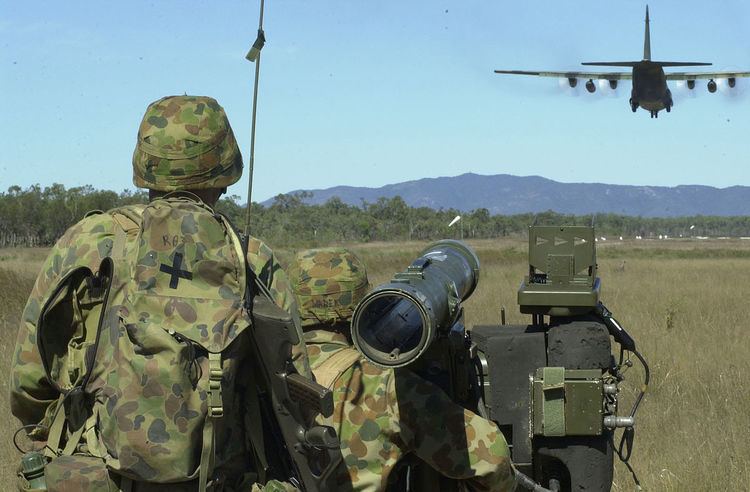Active 2 July 1969 – Present Allegiance Australia Role Air Defence | Country Australia Branch Australian Army Part of 6th Brigade | |
 | ||
The 16th Air Land Regiment is the Australian Army's only ground-based air defence unit. Part of the Royal Regiment of Australian Artillery (RAA), the regiment is responsible for protecting a wide range of military assets during wartime, ranging from Army units in the field to providing point defence to the Royal Australian Navy's support ships and air defence to Royal Australian Air Force air bases. Prior to being equipped with the currently in-service RBS-70 surface-to-air missile system, the regiment was equipped with the Rapier systems for 25 years. The regiment is based at Woodside, South Australia, but frequently deploys with other Australian and allied units on operations and defence exercises. It is part of 6th Brigade.
Contents
History
The regiment is considered to be the "youngest" regiment of the RAA and has its genesis in the amalgamation of two previously independent batteries at Woodside Barracks in South Australia. On 2 July 1969, the 111th LAA Battery and 110th LAA Battery were grouped together to become the 16th Light Anti-Aircraft Regiment. The 111th had been raised in 1957 and had served in Malaysia during Confrontation during 1964–66, while the 110th had been raised in 1965 and replaced the 111th in Malaysia in June 1966, but returned to Australia shortly afterwards after the conflict came to an end. Upon formation, the regiment was initially equipped with the QF 40 mm Mark XII anti-aircraft gun and was placed under the command of Lieutenant Colonel D.J. Ashmore. During this time, the regiment deployed small numbers of personnel to operate the Bofors guns upon the landing craft of the Royal Australian Engineers' 32nd Small Ships Squadron during the Vietnam War.
During 1971, the regiment experienced a manning shortage which resulted in the 110th Battery being placed in "suspended animation", as the regiment was only able to staff one battery. In 1973, the Bofors gun was replaced by the Redeye surface-to-air missile system. The following year the regiment was redesignated as the 16th Air Defence Regiment. The 110th was re-raised in 1978 as the Army moved towards the purchase of a new surface-to-air missile system called the Rapier. At the same time the 111th was re-allocated to the 1st Division as a division air defence battery, although it remained under the regiment's command for administrative purposes. On 1 July that year, the regiment was redesignated the 16th Air Defence Regiment.
In 1979–80, the 110th Air Defence Battery received the Rapier surface-to-air missile system. The following year, the regiment deployed the new capability in August during an exercise at Cultana with the first regimental firing taking place the following November at Beercroft. In 1984, the regiment undertook its largest exercise to that point, deploying to Darwin on 76 flat-bed trucks. The 111th Air Defence Battery replaced the Redeye with the RBS-70 surface-to-air missile system in 1987. Four years later, in 1991, the regiment deployed detachments aboard HMAS Success and Westralia as part of Australia's contribution to the Persian Gulf War. After the September 11 attacks, A Troop from the 111th Air Defence Battery was deployed at short notice to embark on HMAS Kanimbla to provide air and surface defence of her operations in the Persian Gulf. In May 2003, the regiment again deployed a detachment in support of the Royal Australian Navy when a detachment was sent on board Kanimbla during the invasion of Iraq. In 2005, the 110th Air Defence Battery replaced Rapier with the RBS-70.
The regiment has committed air defence batteries to serve as infantry on Operation Astute on two occasions. In 2006, the regiment deployed the 111th Air Defence Battery to Timor Leste as Golf Company of the ANZAC Battle Group. In October 2008, the 110th Air Defence Battery was re-rolled as Golf Company, Timor Leste Battle Group Five, led by the 5th Battalion, Royal Australian Regiment. They returned to Australia in June 2009.
On 1 March 2010, the 16th Air Defence Regiment became part of the re-raised 6th Brigade. Since December 2010 the unit has had members deployed to Operation Slipper in Afghanistan, manning the Counter Rocket, Artillery, and Mortar system deployed to the Multi National Base in Tarin Kot. Other systems were deployed to outlying Patrol Bases mainly within Uruzgan Province, however with the scaling down of the ADF's commitment to Operation Slipper these were withdrawn in late 2012. The regiment has also provided personnel to Operation Mazurka, where they are deployed in a peacekeeping role with the Multinational Force and Observers monitoring the border between Israel and Egypt in the Sinai.
On 9 December 2011, the 16th Air Defence Regiment amalgamated with the 1st Ground Liaison Group to form the 16th Air Land Regiment.
Structure
The regiment currently consists of:
Both the 110th and 111th Air Land Batteries are equipped with the RBS-70 surface-to-air missile system, the Portable Search and Target Acquisition Radar – Extended Range (PSTAR-ER) as well as the G-AMB GIRAFFE Full Operational Capability Radar for detection of rockets and mortars. The 1st Air Ground Ops Battery is responsible for "the coordination and allocation of friendly air assets in support of the land force in the joint war fighting environment" and includes a troop of Joint Terminal Attack Controllers.
The regiment houses a training centre equipped with an Advanced Air Defence Simulator. This consists of high definition projectors inside a dome structure allowing a single RBS-70 detachment to simulate a realistic 360-degree training environment. The simulator is maintained by BAE Systems and was upgraded in 2011.
